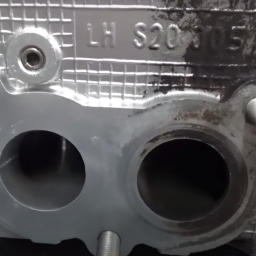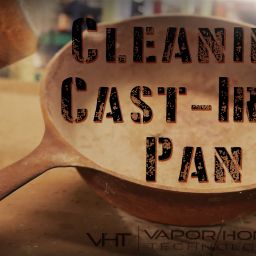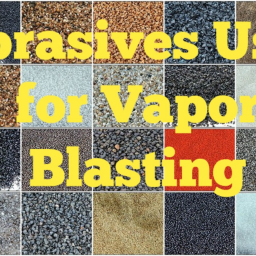The Everything Guide to Choosing and Using a Blast Cabinet
Are cleaning and resurfacing parts and components a regular part of your business’s daily routine? Are you fed up with the mess and dangers associated with traditional sandblasters? If so, you’re far from alone.
Fortunately, there’s a superior way to treat various surfaces, from soft metals to plastics, without fear of warping, pitting, or impregnation of surfaces. And you’ll never have to deal with the messy clean up of mountains of dust, either.
Taking advantage of this technology starts with an investment in a blast cabinet. But what should you look for in a high-quality blast cabinet? Keep reading for our complete guide to finding the best unit for your business’s needs.
What Is a Blast Cabinet?
Let’s start with the basics. After all, it’s difficult to make a solid blast cabinet purchase if you don’t know exactly what you’re getting.
A blast cabinet lets you blast an object under high pressure in a fully enclosed environment. This approach to resurfacing comes with countless advantages. During the treatment process, you’ll wear a specially prepared set of gloves attached to the cabinet.
Apart from these gloves, however, you don’t need to wear any other safety equipment. Why? Because the cabinet proves completely self-contained. So, you never have to worry about abrasives blasting into the open air.
What Are the Advantages of a Blast Cabinet?
A blast cabinet permits you to clean or resurface a part or component with a high-pressure abrasive. This surface treatment technique relies on blasting abrasives to achieve a stripped and smooth surface.
Which types of abrasive media might be used in a blast cabinet? It may include glass beads, metal shots, or glass beads mixed with sodium bicarbonate. Since the abrasive remains within the cabinet throughout the process, you don’t have a messy cleanup.
What’s more, you can reuse the abrasive material, which will save you money and cut down on waste. This is a huge improvement over a traditional sandblaster set up with an air compressor, which leads to tremendous waste and more money spent on abrasive materials.
Because of the enclosed nature of the cabinet, the user also remains protected from the abrasive media. The seals of the blasting cabinet ensure the entire process remains enclosed within the cabinet.
That means workers never have to worry about dust and abrasives flying around. Workers also enjoy the ability to get much closer to their workpiece for precision work.
Contrast this with a blaster gun where you “shoot” the abrasive media towards the object, and you can see the difference.
Do you ever have to worry about leaks from a cabinet? Because of blast cabinet design, this should never be an issue. To ensure your employees’ safety, make sure you choose a high-quality model and keep up maintenance on seals and filters.
How Easy Is It to Use a Blast Cabinet?
After using a traditional sandblaster, you’ll be amazed by how easy it is to operate a blast cabinet. That said, there are some tips you should bear in mind for the best experience.
Start by making sure that the cabinet has sufficient capacity. That way, you can be sure that the cabinet properly de-dusts. This will also ensure that the operator has good visibility throughout the process.
Remember that poor visibility is a common complaint among workers, and it can often be traced back to working with a blast cabinet with an insufficient capacity. Poor visibility leads to poor blasting results and frustrating working conditions.
An insufficient capacity can also lead to excessive dust in the abrasive which will significantly slow down the process. When the process of cleaning and resurfacing items gets slowed down, treating each item ultimately costs your business more money in labor.
Remember that the process of propelling the dust around the cabinet requires plenty of energy via compressed air. Because the dust’s mass remains low, it has no energy and doesn’t contribute in any way to the process’s result.
How does dust get removed from the cabinet at the end of the process? By way of a cyclone. This cyclone allows for recycling the abrasive for reuse, which “disappears” into the dustbin.
What’s the cyclone? It’s a specialized part of the blast cabinet, calculated and developed to match the cabinet’s volume and extraction perfectly.
What Is Vapor Abrasive Blasting?
While a sandblasting cabinet comes with many advantages, it can still prove an aggressive process that isn’t ideal for more delicate surfaces such as soft metals and plastics. For this reason, you should go with a cabinet designed for vapor blasting.
Also known as liquid honing, vapor honing, wet blasting, slurry blasting, and dustless blasting, the process proves more gentle. Why? Because of the introduction of water into the mix.
You’ll still remove contaminants from surfaces. But you’ll gain much greater control when it comes to finishing surfaces because you’ll do so with abrasive media mixed with pressurized water. The combination of abrasive media and water is known as the “slurry.”
The slurry mixture gets mixed in the cabinet hopper before getting injected via a blast nozzle into the cabinet. It also gets mixed with compressed air in the process. Slurry blasting leads to a finer finish than traditional dry blasting.
Why? Because the abrasive media used during treatment gets enveloped in water molecules. The water provides a shield against the abrasive, which means a more gentle approach to removing paint, rust, grease, and other surface contaminants.
Wet Blasting Versus Sandblasting
What are some of the most significant differences between a wet blasting and a dry blasting cabinet? The biggest advantage with vapor honing is a finer finish on the surface. This occurs because the water flushes out the abrasive, avoiding impregnation of the surface blasted.
The process ensures all residual abrasive media and sediment get washed out. The result? A cleaner surface at the end of the blasting.
In a nutshell, water acts as a dampener in the slurry. So, when the abrasive media impacts the blasted surface and the particles shatter (as with dry blasting), they stay contained within the water instead of clouding up. This difference makes collecting the spent media easier.
When should you use wet blasting as a treatment? When you have a surface that requires preservation, always go with aqua blasting. You can use it to de-grease, clean, and blast a surface simultaneously, translating into faster results and fewer labor costs.
Wet Blasting Delivers Superior Results
Once you make the switch to wet blasting, you’ll be amazed by how much time will be saved over a traditional dry abrasive blasting cabinet. What’s more, you can use much finer abrasive media during the vapor honing process.
Why? Because water proves a more effective conduit than compressed air for fine mesh abrasives.
What are some other notable differences between a wet blasting and dry blasting cabinet? A traditional dry blasting cabinet results in a deep anchor profile because the abrasive media impact it at an angle.
But wet blasting results in a water cushion that more evenly disperses the abrasive media. This results in a more consistent, feathered pattern without the risk of deep grooves. The media will also do a better job of getting into tight nooks and crannies.
What Media Is Used for Wet Blasting?
Which abrasive media may be used with a wet blaster? They include any type of blast media. That said, the most common materials are glass beads, aluminum oxide, and ceramic bead.
As for other media such as Green Diamond nickel slag, crushed glass, and copper slag? They’re best left to outdoor wet blasting.
Blast Cabinet Surface Finish Chart
As you’ve already seen, there are different ways to deliver an abrasive medium to a surface that requires treatment. Different delivery methods coupled with different media allow for a wide variety of outcomes.
For example, blast finishing can be powerful enough to remove rust and heavy mill scale from some times. Yet, it proves gentle enough to carefully strip paint from fragile aircraft skins. You’ll want to rely on a blast cabinet surface finish chart to get optimal results.
This chart indicates which media should be used to tackle different jobs. Factors covered in such a chart include:
- Suitability for the purpose (e.g., shape, hardness, density)
- Reusability, breakdown percentage
- Working speed
- Dust levels generated by broken media
- Possibility and consequences of substrate contamination
- Probability of surface removal for close tolerance parts
- Disposal
- Equipment modifications
Whether you need to use silicon carbide, agricultural media, plastic media, or sand, the chart will guide you and provide recommendations. That way, you can always rest assured you achieve the desired results.
Is Soda Blasting Better Than Sandblasting?
How does soda blasting fit into the mix? And how does it differ from sandblasting? When it’s all said and done, you’ll find many similarities between soda blasting and sandblasting.
The primary difference remains the abrasive media used. It’s also worth noting that sandblasting represents the older and more traditional of the two processes. Soda blasting was invited in the 1980s and prove milder than sandblasting.
It relies on sodium bicarbonate (a.k.a. baking soda) as its abrasive media. Yet, you’ll use very similar equipment to clean and resurface objects with it. Soda blasting works best for light rust removal, coating preparation, and smoothing surfaces.
As with sandblasting, the soda gets propelled onto a surface, resulting in a cleaning action. It’s an excellent way to clean and resurface chrome, plastic, and wood. So, consider it for softer surfaces that you’d like to preserve.
In conjunction with vapor blasting, you’ll enjoy the most gentle results. Vapor honing with sodium bicarbonate represents the best way to de grease and parts clean many parts for many different applications.
It also helps with cleaning surfaces for masonry applications and wooden surfaces such as doors and decks.
How Much Does a Blast Cabinet Cost?
As you can see, there are countless blast cabinet uses. But how much do they cost? The final price tag will depend on whether you go with a dry blast cabinet or a wet blasting cabinet. You’ll also need to consider the size and blast cabinet brands carefully.
When it comes to dry blast cabinets, expect to pay anywhere from $150 for small, low-end units to upwards of $5,500 or more for heavy industrial blast cabinets. The highest-end models may go for upwards of $7,500 but make up for excess price with better performance and durability.
As we discussed above, you can use sodium bicarbonate in place of sand in these cabinets. So, there’s no need to look for specialized options if you’d like to soda blast objects.
As for vapor honing cabinets? Prices are also conditional on the brand you choose, the cabinet’s size, and its overall quality. You should expect to pay anywhere from $1,500 to $6,500 or far more for an industrial capacity unit.
Check out these vapor honing cabinets to get a better idea of pricing, dimensions, and more. Or check out this article for a thorough breakdown of vapor honing machine costs.
Vapor Honing, Dry Blasting, and Soda Blasting Cabinets
As you can see, you have plenty of options when it comes to the best blast cabinet for your company’s needs. Of course, the most traditional approach remains a dry sandblasting cabinet. But it comes with disadvantages from inconsistent surfacing to overly aggressive angles and tons of hazardous dust.
Soda blasting softens the effect of sandblasting, and is a fantastic option for removing paint, light rust, chrome, and other think surface substances. But if you’re after the greatest versatility from one investment, nothing beats a vapor honing cabinet.
It provides the gentlest method of removal while providing superior cleaning and surfacing. Are you ready to explore the many advantages of investing in a wet blasting machine? Here’s what you need to know about these handy devices and their many uses.








